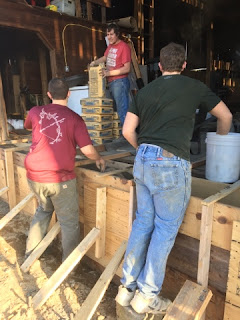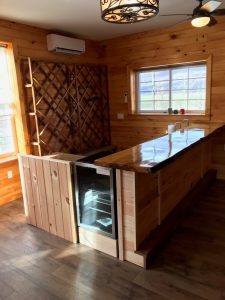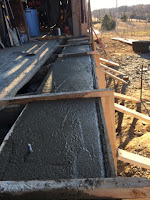We had purchased a large, live edge, unfinished slab of wood to use for the bar top. After rough sanding it with a belt sander, we finished it by hand-sanding, using finer and finer sandpaper between applying coats of high gloss polyurethane. We started off with 80 grit sandpaper and at the end we were using 800 grit sandpaper! It took about 30 coats of polyurethane and sanding (we lost track of the exact number) over a period of two months. But it was so worth it:
Chronicles of the Long Shot Farm
DIY
Upper Barn Remodel Week 1 – Concrete
 With the warmer temperatures, we were able to do the basic concrete work that is literally the foundation of fixing the exterior wall on the back of the upper barn. We needed to reinforce the section of the loading area, in front of the stone wall, so we can then install a new footer and frame in the barn doors.
With the warmer temperatures, we were able to do the basic concrete work that is literally the foundation of fixing the exterior wall on the back of the upper barn. We needed to reinforce the section of the loading area, in front of the stone wall, so we can then install a new footer and frame in the barn doors.
The first step was building a “form”, into which the concrete would be poured. We used plywood, reinforced with 2×4’s and metal posts. We did this 2 weekends ago, which meant that the old barn doors could not be closed tightly, as the “form” stuck out too much. We had to use old barn beams to prop the doors shut from the outside. Luckily, this held the doors for a week.
 On Saturday, we started mixing and pouring concrete – we all worked on this most of the day. Zach brought over his electric cement mixer, and while he mixed the concrete, Lars would use the wheelbarrow to take the mixed concrete and pour it into the form, where Jens would poke it down and use an air driven drill with a blunted tip to “vibrate” the concrete by pushing the running drill on the outside of the form. We used 70 bags of concrete on Saturday, and as we got near the end, one side of the form gave out under all the pressure – we lost about half our work 🙁
On Saturday, we started mixing and pouring concrete – we all worked on this most of the day. Zach brought over his electric cement mixer, and while he mixed the concrete, Lars would use the wheelbarrow to take the mixed concrete and pour it into the form, where Jens would poke it down and use an air driven drill with a blunted tip to “vibrate” the concrete by pushing the running drill on the outside of the form. We used 70 bags of concrete on Saturday, and as we got near the end, one side of the form gave out under all the pressure – we lost about half our work 🙁
On Sunday, we got more concrete, fixed the form and reinforced it even more, and started the process over. We did get it all done by the middle of the afternoon.
This evening, we “popped” the form off, and could admire the new outside wall of what will be the loading area for the upper barn.
Working on the Driveway
We started phase two of our driveway project in January, with a”backhoe expert” reshaping the bank on the back of the barn and re-positioning dirt to match the engineering drawings. The driveway section up to the barn is pretty much done, but we need to get at least ten dump truck loads of dirt hauled in to finish shaping the parking lot to the required specifications.
Lucky for us, PennDOT asked if they could reshape the bank below the vineyard – to reduce water run-off. And we get to keep all the dirt they have to move!! They plan to excavate sometime in February.
We bought two dump truck loads of shale to cover the driveway section up to the barn and built a wooden form for concrete to reinforce the section of the stone wall below the large barn doors. Now we are waiting for a warm day to pour the concrete.
Building a Dog Fence (with the help of the Skidril)
Since Ruger needs a lot of space to run, we decided to tear out the decorative picket fence and replace it with a “dog fence”. We mapped out a larger perimeter fence for our backyard, dug corner post and gate post holes, and used concrete to set the 4″ x 4″ wooden posts. We then measured where each metal post needed to be set, and marked the spots with orange paint. Today, Lars used the Skidril to drive all the posts (about 40) in less than an hour. We helped by holding the post – and using a level to keep it straight. Here is a link to a short video of the first post we set.
Skidril
We got a gas powered, handheld fence post driver. Ours is made by a company called Skidril (which is how we refer to this tool by now). Probably one of the best tools ever for putting in metal trellis posts. It works so much faster than drilling holes with a tractor attachment, and then pounding in the wooden posts with another tractor attachment. And – with the handheld tool, we can easily replace or add posts when the grapevines or blackberry bushes are already established.
Of course it does take some stamina, and balance and in our case a crew of three people. We marked the field where the posts had to be placed before we got started, and build a platform for the truck for one person to stand on to use the post driver. The second person held the post in place with a level to keep it straight, and the third person drove the truck. They managed to set about 80 posts in an hour!
And, the Skidril has a jackhammer attachment, which will come in really handy once we put in expanded drainage troughs in the barn…







